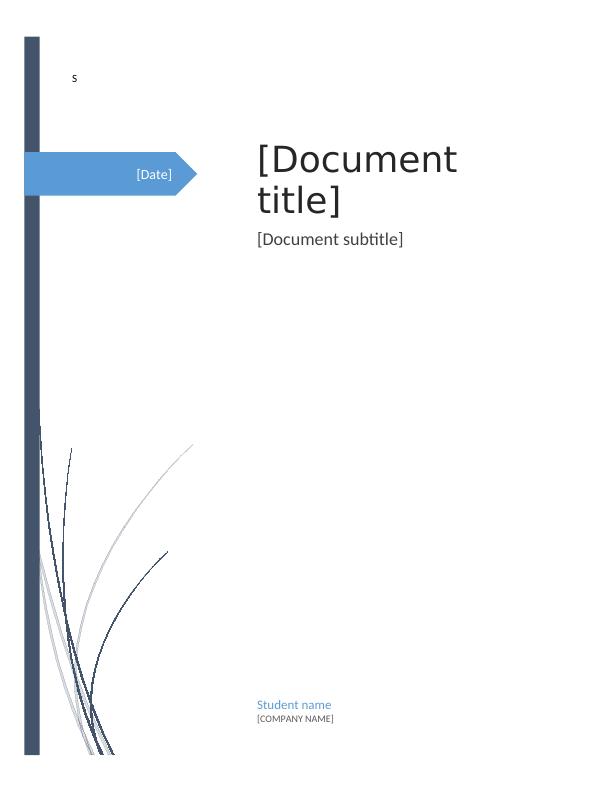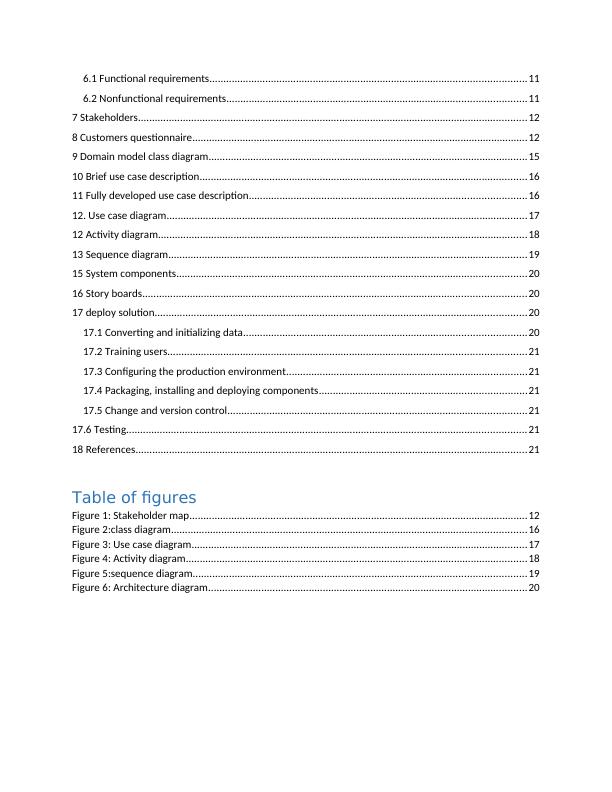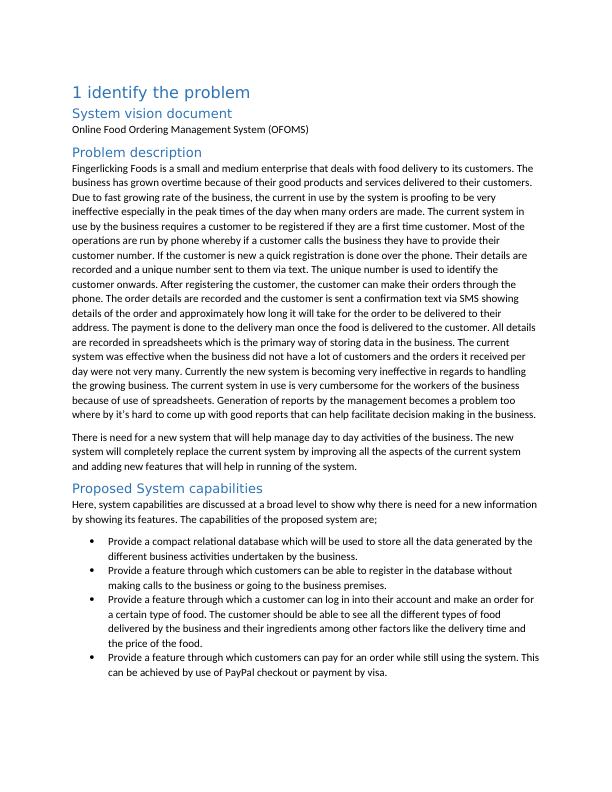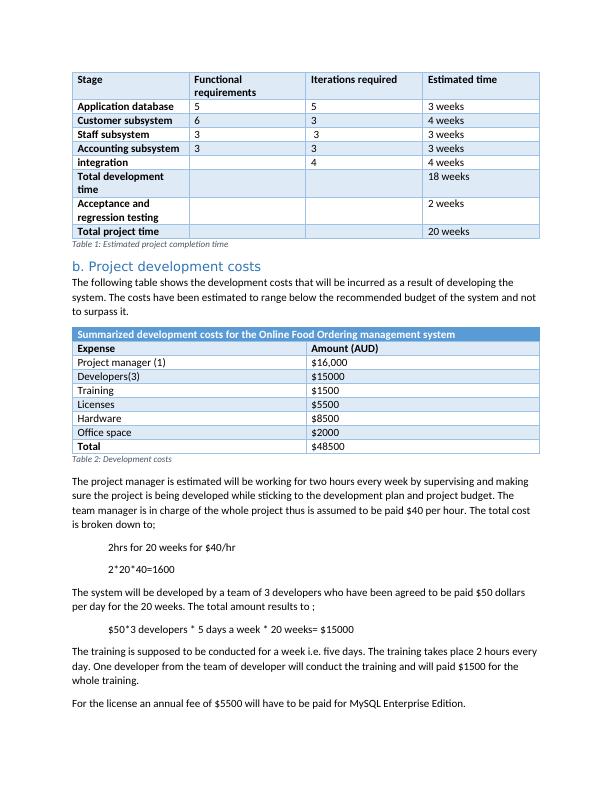Online Food Ordering Management System
24 Pages6128 Words420 Views
Added on 2020-03-28
Online Food Ordering Management System
Added on 2020-03-28
ShareRelated Documents
[Date]SStudent name[COMPANY NAME][Document title][Document subtitle]

ContentsTable of figures............................................................................................................................................11 identify the problem.................................................................................................................................2System vision document..........................................................................................................................2Problem description................................................................................................................................2Proposed System capabilities..................................................................................................................2Business benefits of the proposed system..............................................................................................32 Quantity project approval factors.............................................................................................................3a. Estimated time for project completion................................................................................................3b. Project development costs..................................................................................................................4C. Estimated annual operating costs.......................................................................................................5d. cost benefit analysis............................................................................................................................5I. Anticipated benefits..........................................................................................................................5II. Estimated annual benefits...............................................................................................................63 Risk and feasibility analysis.......................................................................................................................6a. Organization risks and Feasibility.........................................................................................................6b. Technological Risks and feasibility.......................................................................................................6c. resources risk and feasibility................................................................................................................7d. Schedule Risks and feasibility..............................................................................................................74. Project environment................................................................................................................................7a. Information captured..........................................................................................................................7b. Work environment..............................................................................................................................7C Processes and procedures....................................................................................................................8Reporting and documentation.............................................................................................................8Programming.......................................................................................................................................8Testing.................................................................................................................................................8Deliverables.........................................................................................................................................8Code and version control.....................................................................................................................85. Schedule the work...................................................................................................................................9a. Work breakdown structure..................................................................................................................9B Gantt chart.........................................................................................................................................106 Functional and non-functional requirements.........................................................................................11

6.1 Functional requirements.................................................................................................................116.2 Nonfunctional requirements...........................................................................................................117 Stakeholders...........................................................................................................................................128 Customers questionnaire........................................................................................................................129 Domain model class diagram..................................................................................................................1510 Brief use case description.....................................................................................................................1611 Fully developed use case description...................................................................................................1612. Use case diagram.................................................................................................................................1712 Activity diagram....................................................................................................................................1813 Sequence diagram................................................................................................................................1915 System components.............................................................................................................................2016 Story boards.........................................................................................................................................2017 deploy solution.....................................................................................................................................2017.1 Converting and initializing data.....................................................................................................2017.2 Training users................................................................................................................................2117.3 Configuring the production environment......................................................................................2117.4 Packaging, installing and deploying components..........................................................................2117.5 Change and version control...........................................................................................................2117.6 Testing...............................................................................................................................................2118 References............................................................................................................................................21Table of figuresFigure 1: Stakeholder map.........................................................................................................................12Figure 2:class diagram...............................................................................................................................16Figure 3: Use case diagram........................................................................................................................17Figure 4: Activity diagram..........................................................................................................................18Figure 5:sequence diagram.......................................................................................................................19Figure 6: Architecture diagram..................................................................................................................20

1 identify the problemSystem vision documentOnline Food Ordering Management System (OFOMS)Problem descriptionFingerlicking Foods is a small and medium enterprise that deals with food delivery to its customers. The business has grown overtime because of their good products and services delivered to their customers. Due to fast growing rate of the business, the current in use by the system is proofing to be very ineffective especially in the peak times of the day when many orders are made. The current system in use by the business requires a customer to be registered if they are a first time customer. Most of the operations are run by phone whereby if a customer calls the business they have to provide their customer number. If the customer is new a quick registration is done over the phone. Their details are recorded and a unique number sent to them via text. The unique number is used to identify the customer onwards. After registering the customer, the customer can make their orders through the phone. The order details are recorded and the customer is sent a confirmation text via SMS showing details of the order and approximately how long it will take for the order to be delivered to their address. The payment is done to the delivery man once the food is delivered to the customer. All details are recorded in spreadsheets which is the primary way of storing data in the business. The current system was effective when the business did not have a lot of customers and the orders it received per day were not very many. Currently the new system is becoming very ineffective in regards to handling the growing business. The current system in use is very cumbersome for the workers of the business because of use of spreadsheets. Generation of reports by the management becomes a problem too where by it’s hard to come up with good reports that can help facilitate decision making in the business.There is need for a new system that will help manage day to day activities of the business. The new system will completely replace the current system by improving all the aspects of the current system and adding new features that will help in running of the system.Proposed System capabilitiesHere, system capabilities are discussed at a broad level to show why there is need for a new informationby showing its features. The capabilities of the proposed system are;Provide a compact relational database which will be used to store all the data generated by the different business activities undertaken by the business.Provide a feature through which customers can be able to register in the database without making calls to the business or going to the business premises.Provide a feature through which a customer can log in into their account and make an order for a certain type of food. The customer should be able to see all the different types of food delivered by the business and their ingredients among other factors like the delivery time and the price of the food.Provide a feature through which customers can pay for an order while still using the system. Thiscan be achieved by use of PayPal checkout or payment by visa.

Provide a feature through which the staff of the business all orders. These orders include the most recent orders which have just arrived. The staff should then coordinate with the respectiveto make sure that the food is prepared and delivered on time.Provide an accounting system for the business through which the business can see all the moneygenerated by orders within a certain timeline.Business benefits of the proposed systemThe main reason for purchasing the proposed system is to improve on the business process so that the business may realize more profits an ultimately maintain a positive growing trend. This will be achieved through use of the different features mentioned above by all the involved stakeholders. The visible benefits if implementing the new system are;The new system will help ease the process of making an order by a customer thus giving the customer more satisfaction.The new system will provide an easy way of managing orders made by the customers thus the staff will be able to serve and deliver in time thus leading to customer satisfaction.The new system will provide an easy way of paying for orders by the customers where by customers will be able to make a payment after making an order.The new system will help the management to generate different reports that can be used to help make business related decisions for the business. The data can also be used for other services like customer segmentation whereby for example a segment for loyal customers can be derived from doing an analysis on the data. This can only be possible if a compact database has been designed and deployed to act as the backend of the application system.The new system will help the business to advertise its different range of products. When a customer visits the online application, they are able to see all the different types of foods that they can order. The current system relies on making flyers which are given to customers during delivery. This method is not very effective as compared to the online application which is easy toconvince the customer by use of images and videos which cannot be put on a flyer.The new application system will also help the business to have an online presence thus reaching a wider base of customers.2 Quantity project approval factorsa. Estimated time for project completionThe estimated time for project completion is based on the different stages that the whole project will gothrough until the end product is delivered to the customer. The basic time factor to be used to breakdown the time used for various stages is weeks where by work on the project will be done for five days every week and for six hours every day. The project is s undertaken throughout the projected development time but unforeseen cases which might cause the projected time to increase can be considered if they arise underway during the project development.Estimated completion time for Online Food Ordering System

StageFunctional requirementsIterations requiredEstimated timeApplication database553 weeksCustomer subsystem634 weeksStaff subsystem3 33 weeksAccounting subsystem333 weeksintegration4 4 weeksTotal development time18 weeksAcceptance and regression testing2 weeksTotal project time20 weeksTable 1: Estimated project completion timeb. Project development costsThe following table shows the development costs that will be incurred as a result of developing the system. The costs have been estimated to range below the recommended budget of the system and not to surpass it.Summarized development costs for the Online Food Ordering management systemExpenseAmount (AUD)Project manager (1)$16,000Developers(3)$15000Training$1500Licenses$5500Hardware$8500Office space$2000Total$48500Table 2: Development costsThe project manager is estimated will be working for two hours every week by supervising and making sure the project is being developed while sticking to the development plan and project budget. The team manager is in charge of the whole project thus is assumed to be paid $40 per hour. The total cost is broken down to;2hrs for 20 weeks for $40/hr2*20*40=1600The system will be developed by a team of 3 developers who have been agreed to be paid $50 dollars per day for the 20 weeks. The total amount results to ;$50*3 developers * 5 days a week * 20 weeks= $15000The training is supposed to be conducted for a week i.e. five days. The training takes place 2 hours everyday. One developer from the team of developer will conduct the training and will paid $1500 for the whole training.For the license an annual fee of $5500 will have to be paid for MySQL Enterprise Edition.

End of preview
Want to access all the pages? Upload your documents or become a member.
Related Documents
Database in Software Engineerlg...
|27
|3556
|21
Specification and Design Document for Sunshine Motorslg...
|22
|2249
|20
System and Design Document for Online Library Management Systemlg...
|21
|2836
|213
Case Study on System Analysis and Design of an Australia Based Organizationlg...
|34
|6285
|452
ISTM 6201 Information Systems Development Assignmentlg...
|49
|5662
|73
Re-design of Guest Tracker Application Report 2022lg...
|23
|4171
|40
